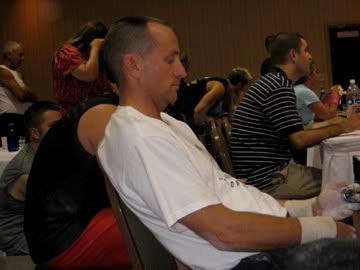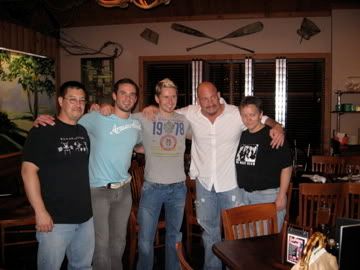After all that stressing the need for proper citation, I'm going to post something I can't give a sure source for. I think I found this on Tommy Fannon's "Outlaw (Powerlifting) Forum" years ago, but can't remember for sure. I don't know who the original author is, however, this site claims it as their own: The Iron Dungeon.HOW TO BECOME A GOD OF THE IRON!!!Have you always wanted to be one of those feared monsters in the gym, but never knew the secret? Have people covered their eyes in fear when you walk past? Do you see little scrawny guys scurry away from the fountain when you grunt, or have an entourage follow you around to watch your every lift, in absolute awe? Well, you've got to get noticed, and do the stylin' squat. Here's the guide for doing squats to ensure the fastest growth in your gym prowess: (meatheads need not apply)
Step 1: Preparation
For your "initiation day" at the gym (the one that will set you well on your way to monsterhood), you should have the following ready:
- Chalk (find some that makes the biggest cloud that hangs in the air for the longest time after you clap your hands with it). Store it in a tupperware container, important for the veteran look.
- Powerlifting belt. 4-6 inches on the back. Essential. The biggest prongs and buckle you can find. It must be leather, too. Remember to remove the price tag.
- Knee wraps. If you can find them, get ones that take about 5 minutes to wrap. Any less just won't do.
- Get a crew cut. Everybody knows a short haircut makes you look bigger.
- Cheap water bottle.
- Practice the ILS strut -- walk around like you've got barrels under your arms, the bigger the better.
Step 2: The Walk
Go to the squat rack, and nothing but the squat rack. You must find the most direct line, even if that means walking over a benchpress or through a conversation between monster- heads. Don't be intimidated. You're going to earn their respect today. If anyone talks to you on your way, you must ignore them, with your eyes fixed on the rack. You mustn't talk, as this takes away from your intense look. During the walk, you musn't trip over anything, as this doesn't look good either. If necessary, practice the direct-route walk when the gym is empty, so you know where the difficult areas are.
Step 3: Taking the Rack
When you arrive at the rack, if there's a skinny guy doing curls, then push him over, and say, "get outta here, rat!" Make sure he gets hurt when he falls. Clench your jaw together when you're doing this, for additional effect. If there's a big guy, then hang off for a while, standing near the rack, but make sure your lats are flexed 'til they cramp, and in complete view of the rest of the gym -- it helps if you tuck in your tank top. It's much better if you time your entrance (beginning of step 2) so that there's no big guy at the rack by the time you've finished your Walk.
Step 4: The Setup
Now that you have your own rack (or cage), it's important to get some attention. Drop your gear near the rack as loudly as possible, preferably so that the prongs of the belt hit something metallic.
Look in the mirror in front of you to see if anybody heard, if not, then make sure the supports in the cage are strong by hitting them loudly with the side of your hand as hard as you can without getting a bruise.
Now, pick up your belt and cinch it up as tight as you can manage. Tighten until your waist is 20 inches. Contrasting your 40 inch chest, you now have an impressive v-taper, just like the pros.
Walk up to the bar, hit it with both hands (again, forcefully enough) grunt at it, and then turn around to check out your audience. The more people near the rack, the more impressive your lift will seem.
Throw on a pair of 45s. Make sure that you throw them on as hard as you can manage without losing your balance. This is an excellent way to cultivate your audience. Next, put on your wraps and double-check your belt. Pick up your water bottle, take a swig, then throw it across the gym. For best effect, it should rocket through the other guy's squat cage, narrowly miss the guy doing 100lb dumbbell presses and hit a far wall.
Now, toss on another pair. You should have 225. This isn't enough for them? Time to throw on another pair. Now we're getting a couple looks, aren't we? Ahh... now's not the time to stop -- you're on a roll, and you're starting to get some respect, so fling on another 90. When the clamor of the weights begins to die, tell somebody nearby, "Hey you... fetch me a couple more plates." 495 on the bar... look who's talking now! You will probably even see the biggest guys in the gym looking out of the corners of their eyes, suppressing their awe. If only Yates could see you now.
Step 5: The Burn
This is a crucial step. Pick some skinny kid nearby and walk up to him, ask him quietly "can I borrow you for a moment?" Walk back to the bar, and wait for him to come near. If all goes as planned, he'll say, "Do you need a spot?" Bingo. Make sure you yell the rest of this loud enough so that everyone around you could hear: "You... spot me? HAHAHAHAHAH Muahahaha.. You couldn't spot a fly if it hit you in the eye." Immediately, pick one of the big guys and say, "Hey bro, got a sec for a quick spot?" You have boosted his ego, so chances are he'll do it. If not, then come up with a good joke about his clothing and pick somebody else (preferably not the deepsquatter).
Reach into your tupperware container of chalk, and rub it across your palms, back of shoulders and neck. Grunt every now and then and mutter some things under your breath. Occasionally say, "piece of cake", "what a joke", or "now we're cookin'". Finally, smash your hands together, but make sure there's a hefty quantity of chalk in the cup of your hands before they hit. This will make sure that all of it explodes into the air. You want the POW camp extras in the aerobics area to be struck with fear by the A-bomb cloud of chalk dust rising over the squat area. This is usually enough to bring over a couple more spectators.
Step 6: The Lift
Now that you're wrapped, chalked, belted and have an enough people watching, it's time to get on with your lift -- if you wait too long, you'll lose people's interest. Walk back up to the bar, again, slap your hands on the bar, and very quickly duck under the bar and smash your shoulders into the bar. This should make the cage rattle with all the weight. You're in position for your Lift.
Make sure your spotter is close behind you, because it's mportant that he obscures you from the crowd watching from behind. You want them to hear your lift, not see it.
When ready, stand, walk out and grunt. You will probably need about 5 grunts to keep people's interest while you're getting ready. Now, start to bend your knees, and go down a couple inches. As soon as you think you've gone far enough, start yelling. Try to roar from the bottom of your stomach, with as much force as possible. Before you start your roar, be sure to get as big a breath as possible. This will allow you to keep a sustained roar for much longer; hyperventilate if you have to. But it's not the length that counts, it's the number of times the roar changes pitch, making it sound like you're going through a series of different levels of agony. Your last note should be unpleasantly loud and should crescendo with you throwing the bar back on the pins. Assuming your yell was long enough, most people will think you came up from parallel, and the spotter should make it difficult to see.
Step 7: The Exit
Step out of the rack, and look around to see what sort of audience you managed to summon. If you've injured yourself, don't cry until you've left the gym. Leave the weight on the bar so that the next person to use it has to take it all off and realize how strong you really are. Ignore your spotter. If he starts to say something about depth, yell over the top of him, "what kind of LOUSY spot was that?" To anything he says after that, just laugh him off immediately. Exit the gym by the same route you took to get in. Do not remove your belt and remember those barrels.
With careful application of these secrets, don't be surprised if you become the new talk of the gym. If the gym tells you they don't want you back (they're usually worried about letting superstrong guys like you make others insecure), find another one. Preferably one of those hardcore ones like Jane Fonda or Bally's.

































